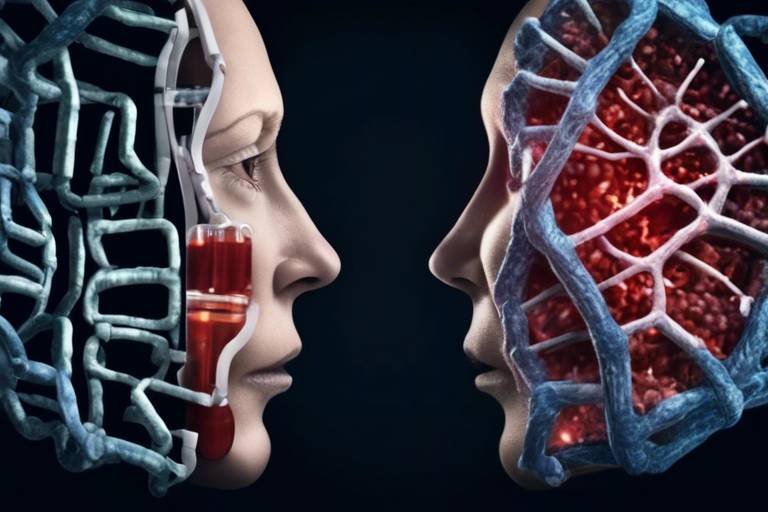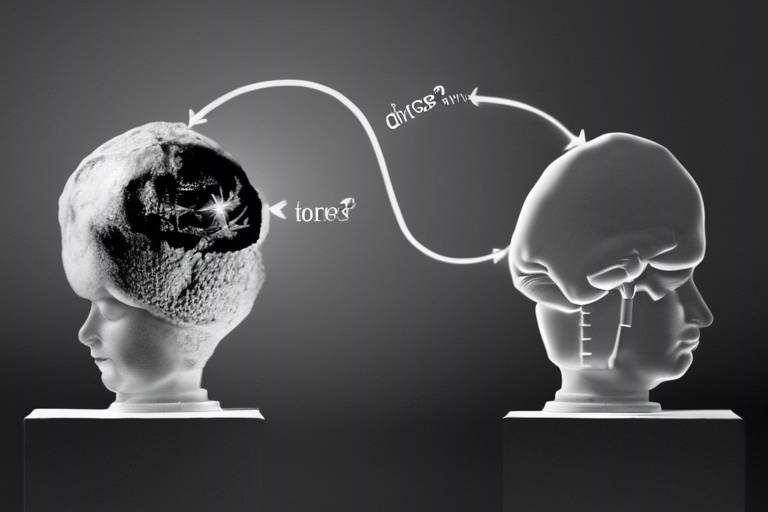The Philosophy of Representation in Cognitive Science
The intricate relationship between representation and cognition is a captivating area of study that has fascinated philosophers, psychologists, and cognitive scientists alike. At its core, the philosophy of representation grapples with the question of how we mentally depict the world around us. Are our mental images mere reflections of reality, or are they constructed through our experiences and interactions? This article dives deep into the various philosophical perspectives that influence our understanding of cognitive processes, particularly focusing on the implications these views have for the field of cognitive science.
Representation can be thought of as the bridge between our internal mental states and the external world. It’s like a map that guides us through the vast landscape of our thoughts and perceptions. Just as a map simplifies the complexities of a territory, our mental representations help us navigate the complexities of reality. However, the accuracy and reliability of these representations are subjects of ongoing debate. How do we know that our mental maps truly reflect the terrain of the world? This question sets the stage for exploring various theories and models that attempt to explain the nature of mental representation.
In cognitive science, understanding representation is not just an abstract exercise; it has practical implications for how we study the mind. For instance, researchers must consider how different models of representation can affect their findings. If we think of representation as a lens through which we view cognitive phenomena, then the choice of lens can dramatically alter our perception. This realization leads to a rich tapestry of theories, each offering unique insights into the workings of the human mind.
The exploration of representation in cognitive science is not merely an academic pursuit; it resonates with our everyday experiences. Think about how we use language to convey thoughts and emotions. Words are not just arbitrary symbols; they carry with them layers of meaning shaped by context, culture, and individual experience. This is where the philosophical perspectives on representation come into play, providing a framework for understanding how we construct knowledge and meaning.
As we embark on this journey through the philosophy of representation, we will encounter various viewpoints, including realism, anti-realism, and constructivism. Each perspective offers a different take on the nature of mental representation and its implications for cognitive science. By dissecting these viewpoints, we can better appreciate the complexities of representation and its critical role in shaping our understanding of cognition.
In the sections that follow, we will delve deeper into these philosophical perspectives, examining how they influence research methodologies and theoretical frameworks within cognitive science. We will also explore the challenges faced in representation theory, such as ambiguity and context-dependence, and look ahead to potential future directions in this fascinating field.
- What is mental representation?
Mental representation refers to the internal cognitive symbols or images that stand for external reality, allowing us to think about and interact with the world. - How do philosophical perspectives influence cognitive science?
Philosophical perspectives shape the frameworks and methodologies used in cognitive science, affecting how researchers interpret and study mental processes. - What are the main challenges in representation theory?
Challenges include issues of ambiguity, context-dependence, and the limitations of current models in capturing the complexity of human cognition.

The Nature of Mental Representation
Understanding what constitutes mental representation is crucial in cognitive science. It’s like peering through a window into the mind, revealing how we perceive, interpret, and interact with the world around us. Mental representation can be defined as the mental imagery and concepts that allow us to think about objects, events, and ideas that are not currently being perceived. Imagine trying to describe your favorite vacation spot to a friend; you rely on your mental representation of that place—the sights, sounds, and feelings—to convey your experience. But how do these representations form, and what theories explain their nature?
Various theories and models have emerged to elucidate this complex phenomenon. For instance, the symbolic representation theory posits that our thoughts can be expressed through symbols and language, much like how a map represents a geographical area. In contrast, the connectionist model suggests that mental representations are distributed across networks of neurons, resembling a web of interconnected ideas rather than isolated symbols. This leads us to ponder: are our thoughts more like a structured library or a chaotic internet of information?
Additionally, the concept of mental imagery plays a significant role in representation. When we visualize a sunset or recall the sound of laughter, we are engaging in a form of mental representation that transcends mere verbal or symbolic expression. This brings us to the question of whether mental representations are inherently subjective or if they can be universally understood across different cultures and experiences.
To delve deeper into the nature of mental representation, let’s consider a few key aspects:
- Types of Mental Representations: These can include visual images, auditory sounds, and abstract concepts. Each type serves a unique purpose in our cognitive processes.
- Formation of Representations: Representations are shaped by individual experiences, social interactions, and cultural contexts. This highlights the importance of environment in cognitive development.
- Functionality: Mental representations facilitate reasoning, problem-solving, and decision-making, acting as cognitive tools that help us navigate our daily lives.
Moreover, the nature of mental representations raises intriguing questions about accuracy and distortion. Are our mental images precise, or do they often reflect our biases and misconceptions? This leads to a fascinating area of research focused on how mental representations can influence our perceptions and judgments, sometimes leading to cognitive biases that affect our decision-making processes.
In summary, the nature of mental representation is a multifaceted and dynamic aspect of cognitive science. It encompasses various theories and models that seek to explain how we mentally depict the world. By exploring these dimensions, we can gain a deeper understanding of not only how we think but also how we relate to the world and to each other. As we continue to investigate this topic, we open the door to new questions and insights that can further illuminate the intricacies of human cognition.

Philosophical Perspectives on Representation
The exploration of representation in cognitive science is not merely a technical endeavor; it is deeply rooted in philosophical inquiry. Different philosophical perspectives provide a rich tapestry from which we can understand how we perceive, interpret, and interact with the world around us. At the heart of this discussion are three dominant viewpoints: realism, anti-realism, and constructivism. Each of these perspectives offers unique insights and challenges that shape our understanding of cognitive processes.
Realism posits that there exists an objective reality independent of human thought and perception. According to this view, our mental representations aim to accurately reflect this reality. For instance, when we think of a tree, realism suggests that our mental image corresponds to an actual tree in the world. This perspective encourages cognitive scientists to seek objective measures and models that can capture the essence of cognitive phenomena. However, the challenge lies in determining how closely our mental representations align with the external world.
On the flip side, anti-realism questions the very existence of an objective reality that can be accurately represented in the mind. This perspective emphasizes the role of human perception and interpretation in shaping our understanding of the world. Anti-realists argue that our mental representations are influenced by cultural, social, and individual contexts, making them inherently subjective. This viewpoint raises critical questions about the validity and reliability of cognitive science research, as it suggests that findings may be contingent upon the observer's perspective.
To further complicate matters, constructivism offers yet another lens through which to view representation. Constructivist theories assert that knowledge and meaning are not simply discovered but are actively constructed through social interactions and personal experiences. This perspective emphasizes the dynamic nature of cognition, suggesting that our mental representations evolve over time as we engage with our environment and with others. For example, a child's understanding of a 'dog' may shift dramatically as they interact with different breeds and hear various descriptions from adults.
These philosophical perspectives do not exist in isolation; they often intersect and inform one another. As cognitive scientists delve into the nature of representation, they must grapple with the implications of these viewpoints. For example, the tension between realism and anti-realism can lead to diverse research methodologies. A realist approach may favor quantitative studies aiming to uncover objective truths, while an anti-realist framework might prioritize qualitative research that captures the richness of subjective experience.
As we navigate these philosophical waters, it's essential to recognize that no single perspective holds all the answers. Instead, they collectively enrich our understanding of cognition. By integrating insights from realism, anti-realism, and constructivism, researchers can develop more comprehensive models of mental representation that account for both the objective and subjective dimensions of human thought.
In conclusion, the philosophical perspectives on representation are not just academic discussions; they have profound implications for how we approach research in cognitive science. By acknowledging the interplay between these viewpoints, we can foster a more nuanced understanding of cognition that embraces complexity and diversity.
- What is the difference between realism and anti-realism?
Realism asserts that there is an objective reality that our mental representations aim to reflect, while anti-realism argues that our perceptions are subjective and influenced by context. - How does constructivism influence cognitive science?
Constructivism emphasizes that knowledge is actively built through experiences and social interactions, shaping how we understand mental representation. - Why are philosophical perspectives important in cognitive science?
These perspectives guide research methodologies, influence theoretical frameworks, and enrich our understanding of cognitive processes.

Realism vs. Anti-Realism
The debate between realism and anti-realism in the context of mental representation is not just an academic exercise; it’s a profound inquiry into how we understand reality itself. At its core, realism posits that there exists a world independent of our thoughts and perceptions. In other words, the objects we perceive have an existence that is not contingent upon our mental states. Imagine walking through a forest; the trees, the air, and the sunlight exist whether or not you’re there to observe them. This viewpoint suggests that our mental representations can accurately reflect this external reality, providing a solid foundation for scientific inquiry.
On the flip side, anti-realism challenges this notion by asserting that our understanding of the world is inherently shaped by our experiences and perceptions. From this perspective, the forest isn’t just a collection of trees and air; it’s also colored by our feelings, thoughts, and cultural contexts. For anti-realists, mental representations are not mere reflections of an objective reality but are constructed through individual and collective experiences. This brings us to a crucial question: if our mental representations are shaped by our subjective experiences, can we ever truly know the world as it is?
To illustrate the differences between realism and anti-realism, consider the following table:
| Aspect | Realism | Anti-Realism |
|---|---|---|
| Nature of Reality | Objective and independent of perception | Subjective and dependent on perception |
| Role of Mental Representation | Accurate reflection of external reality | Constructed through individual and social contexts |
| Implications for Knowledge | Knowledge is about discovering truths | Knowledge is about understanding perspectives |
This dichotomy has significant implications for cognitive science. If we lean towards realism, our research methodologies may emphasize objective measurements and replicable experiments. Conversely, an anti-realist approach might prioritize qualitative research, focusing on how individuals construct their understanding of reality through social interactions and personal experiences.
Moreover, the realism vs. anti-realism debate also plays a pivotal role in shaping our understanding of cognitive phenomena. For instance, when studying language, a realist might argue that words have fixed meanings that correspond to real-world objects. In contrast, an anti-realist would contend that meanings are fluid, influenced by context and usage. This fundamental difference can lead to vastly different interpretations of cognitive processes, affecting everything from educational practices to artificial intelligence development.
In conclusion, the realism vs. anti-realism debate is not merely theoretical; it’s a lens through which we can examine how we comprehend our world and ourselves. As we navigate the complexities of mental representation, it’s essential to remain open to both perspectives, recognizing that our understanding of cognition is enriched by the interplay of objective realities and subjective experiences.
- What is realism in cognitive science? Realism asserts that there is an objective reality that exists independently of our perceptions and that mental representations can accurately reflect this reality.
- How does anti-realism differ from realism? Anti-realism argues that our understanding of reality is shaped by our subjective experiences and perceptions, meaning mental representations are constructed rather than reflective of an objective world.
- Why is the debate important? The realism vs. anti-realism debate influences research methodologies, theoretical frameworks, and our overall understanding of cognitive processes.

Implications for Cognitive Science
The implications of philosophical positions on representation are profound and far-reaching within the realm of cognitive science. When we consider how realism and anti-realism shape our understanding of mental representation, we uncover a landscape where our theories and methodologies are deeply influenced by these philosophical debates. For instance, if we adopt a realist perspective, it suggests that our mental representations correspond closely to external reality, which may lead researchers to develop models that strive for accuracy and fidelity in capturing how the world truly is. On the other hand, an anti-realist stance may encourage a more flexible approach, where the focus shifts to how individuals construct their own realities through subjective experiences.
This divergence in philosophical thought impacts not only theoretical frameworks but also practical research methodologies. For example, a realist approach might prioritize empirical validation through experiments that test the correspondence between mental representations and actual phenomena. Conversely, anti-realist perspectives might emphasize qualitative research methods that explore the richness of individual experiences and the social contexts in which they occur. This can lead to a more nuanced understanding of cognition that acknowledges the complexity and variability inherent in human thought.
Moreover, the implications extend to the development of cognitive models and computational simulations. Researchers must grapple with questions such as: How do we model the mind? Should we aim for a representation that mirrors reality, or should we accept that our cognitive processes are inherently subjective? These questions are not merely academic; they have real-world consequences in fields such as artificial intelligence, where the goal is to create machines that can replicate human-like cognition. Understanding the philosophical underpinnings of representation can guide these endeavors, influencing how we approach the design and implementation of AI systems.
To further illustrate these implications, consider the following table that summarizes the key differences between realist and anti-realist approaches in cognitive science:
| Aspect | Realism | Anti-Realism |
|---|---|---|
| Nature of Reality | Objective and independent of perception | Subjective and constructed through experience |
| Research Methodology | Empirical validation and quantitative analysis | Qualitative research and contextual exploration |
| Cognitive Models | Focus on accuracy and correspondence | Emphasis on variability and individual experience |
In summary, the implications of representation theory in cognitive science are vast and multifaceted. The philosophical stance one adopts can significantly influence research directions, methodologies, and even the interpretation of cognitive phenomena. As we continue to explore the intricacies of mental representation, it becomes increasingly clear that a deeper understanding of these philosophical debates is essential for advancing our knowledge in cognitive science.
- What is mental representation? Mental representation refers to the way in which information is encoded in the mind, allowing individuals to think about and interact with the world around them.
- How do realism and anti-realism differ? Realism posits that mental representations correspond to an objective reality, while anti-realism suggests that these representations are subjective and constructed through personal experiences.
- What are the practical implications of representation theory? Representation theory influences research methodologies, cognitive modeling, and even the development of artificial intelligence, shaping how we understand and replicate cognitive processes.

Constructivist Approaches
When we dive into the realm of in cognitive science, we find ourselves exploring a fascinating landscape where knowledge isn't just handed down like a family heirloom; rather, it's built brick by brick through our experiences and social interactions. Imagine constructing a house: each experience is a brick, and the more experiences you gather, the more robust your understanding becomes. This perspective radically shifts how we view mental representation. Instead of seeing it as a mere reflection of reality, constructivism posits that our mental models are actively shaped by our interactions with the world around us.
One of the core tenets of constructivism is that learning is not a passive absorption of information, but an active process. This means that individuals play a crucial role in shaping their own cognitive frameworks. Think of it like a sculptor molding clay; the sculptor (the learner) takes raw material (information) and shapes it into something meaningful based on their unique experiences and insights. This approach emphasizes the importance of context, suggesting that our understanding of concepts can vary significantly depending on our backgrounds, cultures, and personal histories. In this sense, representation becomes a dynamic and fluid process rather than a static one.
Furthermore, constructivist theories highlight the role of social interactions in shaping our cognitive processes. When we engage in discussions, collaborate on projects, or simply share ideas with others, we are not just exchanging information; we are co-constructing knowledge. This collaborative aspect is vital because it enriches our understanding and allows us to view problems from multiple angles. For instance, in a classroom setting, students working together on a project can challenge each other's assumptions, leading to deeper insights and more robust mental representations. It's like a jazz band where each musician contributes their unique sound to create a harmonious piece; the final product is richer than any individual contribution.
To illustrate these ideas, let’s consider a few key principles of constructivist approaches:
- Active Learning: Learners are encouraged to engage actively with material, fostering deeper understanding.
- Social Interaction: Knowledge is constructed through collaboration and dialogue with others.
- Contextual Learning: The context in which learning occurs significantly influences how knowledge is understood and represented.
In conclusion, constructivist approaches in cognitive science provide a compelling framework for understanding how we construct our mental representations. They remind us that knowledge is not merely a collection of facts but a living, breathing entity shaped by our experiences and interactions. As we continue to explore the complexities of cognition, embracing this perspective can lead to richer insights into how we think, learn, and represent the world around us.
1. What is constructivism in cognitive science?
Constructivism is a theory that posits that individuals construct their own understanding and knowledge of the world through experiences and social interactions, rather than passively receiving information.
2. How does social interaction influence learning?
Social interaction plays a crucial role in learning by allowing individuals to share perspectives, challenge assumptions, and co-construct knowledge, leading to a deeper understanding of concepts.
3. Can you give an example of constructivist learning?
An example of constructivist learning is group projects in classrooms, where students collaborate to solve problems, share ideas, and learn from each other, thus building a richer understanding of the subject matter.
4. What are the implications of constructivism for education?
Constructivism suggests that education should focus on active learning, collaboration, and contextual understanding, encouraging students to engage with material in meaningful ways rather than through rote memorization.

Representation in Artificial Intelligence
When we dive into the fascinating world of artificial intelligence (AI), one of the most compelling questions that arises is: how do machines represent knowledge? Unlike humans, whose mental representations are shaped by a complex interplay of sensory experiences, emotions, and social interactions, AI systems rely on algorithms and data structures to mimic this cognitive process. This raises intriguing challenges and philosophical implications about the nature of representation itself.
At the core of AI is the concept of symbolic representation. Machines use symbols to represent objects, actions, and concepts, much like we do when we think or communicate. However, the difference lies in how these symbols are processed. For instance, a machine learning model might analyze vast datasets to recognize patterns and make predictions, but it doesn't "understand" these patterns in the human sense. It’s as if a skilled chef could replicate a recipe without ever tasting the dish!
To better understand the relationship between representation and AI, we can categorize the approaches into two main types: symbolic AI and subsymbolic AI. Symbolic AI relies on explicit representations of knowledge, using logic and rules to manipulate symbols. On the other hand, subsymbolic AI, exemplified by neural networks, operates on a more abstract level, processing information through interconnected nodes that mimic the way neurons work in the brain. This raises the question: can a machine that lacks conscious awareness truly represent knowledge?
Furthermore, the challenge of replicating human-like cognitive processes brings us to the philosophical implications of representation in AI. For instance, consider the Turing Test, which evaluates a machine's ability to exhibit intelligent behavior indistinguishable from that of a human. If a machine passes this test, does it mean it possesses genuine understanding, or is it merely simulating human-like responses? This dilemma highlights the ongoing debate over whether machines can truly understand the representations they are working with or if they are simply processing data without comprehension.
Moreover, the representation of knowledge in AI is not without its limitations. Machines often struggle with contextual understanding and ambiguity. For example, natural language processing systems may misinterpret the meaning of words based on their context, leading to errors in understanding. This challenge mirrors the way humans sometimes misinterpret messages due to contextual cues, but the difference lies in our ability to leverage a rich tapestry of experiences and emotions to resolve ambiguity.
As we look to the future, the intersection of representation in AI and cognitive science opens up exciting avenues for research. By exploring how machines can better represent knowledge and understand context, we can enhance the capabilities of AI systems. This interdisciplinary approach, drawing insights from philosophy, cognitive science, and artificial intelligence, may lead to breakthroughs that not only improve machine learning but also deepen our understanding of human cognition.
- What is representation in AI? Representation in AI refers to how machines symbolize and process information to mimic cognitive functions.
- How do symbolic and subsymbolic AI differ? Symbolic AI uses explicit symbols and rules, while subsymbolic AI relies on neural networks and abstract representations.
- Can machines truly understand their representations? This is a debated topic; while machines can process data effectively, their understanding lacks the depth of human cognition.
- What are the challenges of representation in AI? Key challenges include contextual understanding and ambiguity in language, which can lead to misinterpretation.

Challenges in Representation Theory
The study of representation theory in cognitive science is akin to navigating a labyrinth—complex, intricate, and often perplexing. One of the primary challenges researchers face is the issue of ambiguity. Just as a word can have multiple meanings, representations can be interpreted in various ways depending on the context. This ambiguity can lead to misunderstandings and misinterpretations of cognitive processes. For instance, consider the word "bank." In one context, it refers to a financial institution, while in another, it signifies the side of a river. Similarly, mental representations can shift meaning based on the surrounding circumstances, making it crucial for cognitive scientists to carefully consider context when analyzing how we represent knowledge.
Another significant challenge is context-dependence. Our mental representations are not static; they evolve and adapt based on new information and experiences. This dynamic nature complicates the task of creating models that accurately capture how we think and perceive the world. Imagine trying to paint a moving landscape—every brushstroke must account for the shifting scenery. In the same vein, cognitive models must be flexible enough to incorporate the fluidity of human thought. Researchers are continually grappling with how to design frameworks that can accommodate this variability while still providing meaningful insights into cognitive processes.
The limits of current models also present a formidable barrier in representation theory. Many existing frameworks struggle to encapsulate the complexity of human cognition. For instance, traditional computational models often fail to account for the rich, qualitative aspects of our mental life, such as emotions, intuition, and creativity. These elements play a crucial role in how we construct representations and make decisions. Thus, there is a growing recognition that we need to develop more holistic approaches that integrate not just logical reasoning but also the emotional and experiential dimensions of cognition.
To illustrate these challenges, consider the following table that summarizes key issues in representation theory:
| Challenge | Description |
|---|---|
| Ambiguity | Multiple interpretations of representations based on context. |
| Context-Dependence | Dynamic nature of mental representations influenced by new information. |
| Model Limitations | Inability of current models to capture the complexity of human cognition. |
In summary, the challenges in representation theory are multifaceted and require a concerted effort from researchers across disciplines. As we continue to unravel the mysteries of how we represent knowledge, it becomes increasingly clear that a collaborative approach—drawing insights from philosophy, cognitive science, and even artificial intelligence—will be essential. By addressing these challenges head-on, we can pave the way for a deeper understanding of our cognitive processes and the intricate web of representation that underpins them.
- What is representation theory? Representation theory studies how we mentally depict and understand the world around us.
- Why is ambiguity a challenge in representation theory? Ambiguity arises when representations can have multiple meanings, complicating our understanding of cognitive processes.
- How does context influence mental representations? Context can change the meaning and interpretation of representations, making them dynamic rather than static.
- What are the limitations of current cognitive models? Many models fail to account for the qualitative aspects of cognition, such as emotions and creativity.

Context and Ambiguity
When we dive into the realm of context and ambiguity, we're stepping into a complex web that intertwines our understanding of representation with the nuances of human cognition. Imagine trying to decipher a text message from a friend without knowing the context of your conversation. Is it a joke? A serious comment? The meaning can shift dramatically based on the surrounding circumstances. This is the essence of how context plays a pivotal role in shaping our interpretations of representations.
In cognitive science, ambiguity presents a significant challenge. Words, symbols, and even images can have multiple meanings depending on their context. For instance, consider the word "bank." It could refer to a financial institution or the side of a river. The representation of this word in our minds is heavily influenced by the context in which it is used. This phenomenon raises questions about how effectively current models of representation can capture the intricacies of human understanding.
Furthermore, ambiguity isn't just a nuisance; it can also be a source of creativity and richness in communication. Think of poetry or art, where ambiguity invites multiple interpretations, allowing individuals to engage with the material on a personal level. This duality—where context can both clarify and complicate understanding—highlights the need for cognitive scientists to develop more sophisticated models that account for these variables.
To illustrate how context influences representation, let's look at a simple table that categorizes different types of ambiguity:
| Type of Ambiguity | Description | Example |
|---|---|---|
| Lexical Ambiguity | Words with multiple meanings | "Bat" (the animal vs. the sports equipment) |
| Syntactic Ambiguity | Ambiguity in sentence structure | "I saw the man with the telescope." |
| Pragmatic Ambiguity | Context-dependent meaning | "Can you pass the salt?" (request vs. question) |
As we navigate through these layers of representation, we must also consider how cognitive scientists approach the study of ambiguity. They often utilize experimental methods to explore how individuals interpret ambiguous stimuli in different contexts. These studies reveal that our cognitive processes are not just about the information presented but also about the environment and prior knowledge we bring to the table.
In conclusion, the interplay of context and ambiguity challenges us to rethink how we conceptualize representation in cognitive science. By recognizing that our understanding is often fluid and context-dependent, we can begin to develop richer models that better reflect the complexities of human cognition. As we move forward, the integration of interdisciplinary insights will be crucial in addressing these challenges and enhancing our grasp of mental representation.
- What is mental representation? Mental representation refers to the way in which information and experiences are symbolically encoded in our minds, allowing us to understand and interact with the world.
- How does context influence representation? Context shapes our interpretation of words, symbols, and images, leading to different meanings based on our surrounding circumstances.
- What are some challenges in representation theory? Key challenges include ambiguity, context-dependence, and the limitations of current models in accurately capturing the complexity of human cognition.
- Why is ambiguity important in communication? Ambiguity can enhance creativity and engagement, allowing for multiple interpretations and deeper connections with the material.

Future Directions in Representation Research
The field of representation research is at a fascinating crossroads, with numerous avenues ripe for exploration. As we delve deeper into the complexities of how we understand and depict our world, several key areas emerge as particularly promising for future inquiry. One of the most exciting prospects lies in the integration of interdisciplinary approaches. By combining insights from philosophy, cognitive science, and artificial intelligence, researchers can develop a more holistic understanding of mental representation.
For instance, the collaboration between cognitive scientists and AI developers could lead to breakthroughs in how machines interpret and replicate human-like cognitive processes. Imagine a world where artificial intelligence not only processes data but also understands the nuances of human thought and emotion. This could revolutionize fields such as education, healthcare, and social interaction, where understanding representation plays a critical role.
Moreover, there is a growing recognition of the role that social context plays in shaping our mental representations. Future research could focus on how cultural differences influence cognitive processes. For example, how do different societies construct knowledge, and how does this affect the way individuals from these societies perceive and interact with the world? Exploring these questions could lead to more effective communication strategies and enhance cross-cultural understanding.
Additionally, the challenge of ambiguity in representation theory remains a significant hurdle. Future studies could investigate how context influences the interpretation of symbols and language, aiming to develop models that can better account for these complexities. This could involve creating more sophisticated algorithms that recognize context-dependent meanings, thus improving the performance of AI systems in natural language processing.
As we look ahead, it's also essential to consider the ethical implications of advancements in representation research. The ability to create machines that can mimic human cognitive processes raises questions about consciousness, identity, and agency. How do we ensure that these technologies are developed responsibly, respecting the intricacies of human cognition while pushing the boundaries of what machines can do?
In summary, the future of representation research is not just about understanding how we depict the world; it’s about embracing a multi-faceted approach that includes technology, culture, and ethics. As we navigate these uncharted waters, collaboration across disciplines will be crucial in unlocking the full potential of our cognitive capabilities and the technologies that aim to replicate them.
- What is mental representation? Mental representation refers to the way in which information about the world is internally depicted in our minds, influencing our thoughts, beliefs, and actions.
- Why is representation important in cognitive science? Representation is foundational in understanding how we process information, make decisions, and interact with our environment, making it a key focus in cognitive science.
- How does artificial intelligence relate to representation? AI seeks to replicate human cognitive processes, which involves understanding and creating representations of knowledge, language, and context.
- What are the implications of constructivist approaches to representation? Constructivist theories highlight how knowledge is built through social interactions and experiences, suggesting that learning is a dynamic and collaborative process.
Frequently Asked Questions
- What is mental representation in cognitive science?
Mental representation refers to the ways in which our minds depict and understand the world around us. It's like having a mental map that helps us navigate our experiences and knowledge. In cognitive science, it plays a crucial role in understanding how we process information, make decisions, and interact with our environment.
- How do philosophical perspectives influence cognitive science?
Philosophical perspectives, such as realism and anti-realism, shape how researchers approach cognitive phenomena. For instance, realism suggests that representations correspond to actual entities in the world, while anti-realism posits that our understanding is shaped by social contexts and individual experiences. These views can affect research methodologies and the interpretation of cognitive processes.
- What are the challenges in representation theory?
Representation theory faces several challenges, including ambiguity and context-dependence. For example, the same word or symbol can mean different things in different contexts, leading to confusion. Additionally, current models sometimes struggle to capture the full complexity of human cognition, which adds another layer of difficulty in understanding how we represent knowledge.
- How does artificial intelligence relate to representation?
In artificial intelligence, representation is key to developing systems that can mimic human cognitive processes. However, replicating these processes is challenging due to the nuances of human thought and the philosophical implications of creating machines that can 'think'. This raises questions about the nature of understanding and consciousness in both humans and machines.
- What future directions are being explored in representation research?
Future research in representation theory is likely to focus on interdisciplinary approaches that combine insights from philosophy, cognitive science, and artificial intelligence. This could lead to a deeper understanding of how representations are formed and utilized, potentially paving the way for advancements in both cognitive science and AI technologies.



















